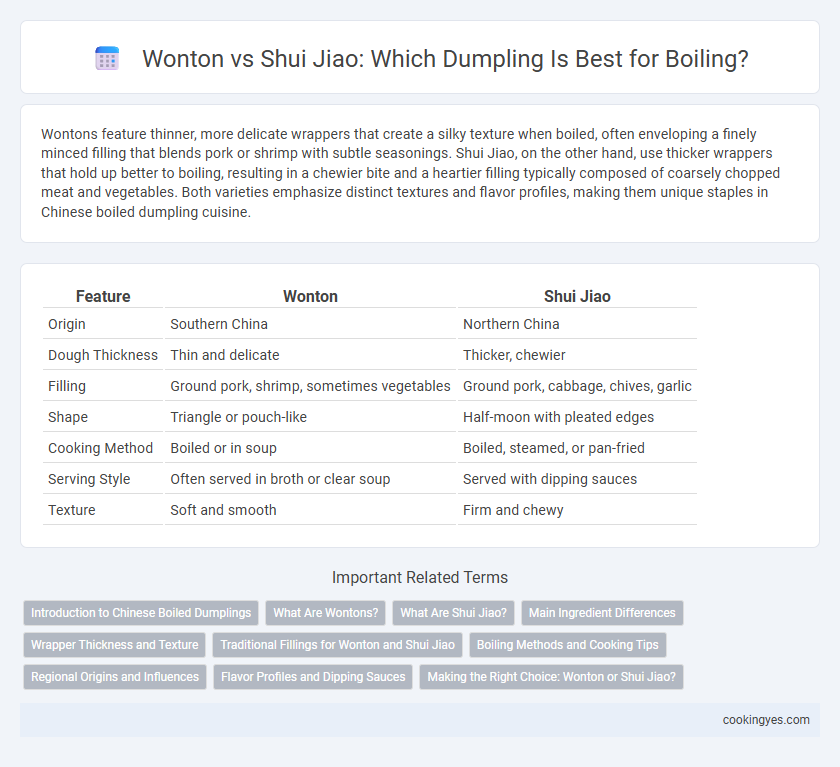Wontons feature thinner, more delicate wrappers that create a silky texture when boiled, often enveloping a finely minced filling that blends pork or shrimp with subtle seasonings. Shui Jiao, on the other hand, use thicker wrappers that hold up better to boiling, resulting in a chewier bite and a heartier filling typically composed of coarsely chopped meat and vegetables. Both varieties emphasize distinct textures and flavor profiles, making them unique staples in Chinese boiled dumpling cuisine.
Table of Comparison
| Feature | Wonton | Shui Jiao |
|---|---|---|
| Origin | Southern China | Northern China |
| Dough Thickness | Thin and delicate | Thicker, chewier |
| Filling | Ground pork, shrimp, sometimes vegetables | Ground pork, cabbage, chives, garlic |
| Shape | Triangle or pouch-like | Half-moon with pleated edges |
| Cooking Method | Boiled or in soup | Boiled, steamed, or pan-fried |
| Serving Style | Often served in broth or clear soup | Served with dipping sauces |
| Texture | Soft and smooth | Firm and chewy |
Introduction to Chinese Boiled Dumplings
Chinese boiled dumplings, known as jiaozi, come in various regional styles, with wonton and shui jiao being two popular types. Wontons typically feature a thinner, smoother wrapper and are often filled with a mixture of pork and shrimp, then boiled and served in broth. Shui jiao dumplings have a thicker, chewier skin, often stuffed with ground pork and cabbage, providing a heartier texture when boiled.
What Are Wontons?
Wontons are a type of Chinese dumpling characterized by a thin, delicate wrapper made from wheat flour and water, typically filled with a mixture of ground pork, shrimp, and seasonings. Unlike shui jiao, which often have a thicker skin and diverse fillings, wontons are usually smaller and served in a flavorful broth or soup. Their unique shape, often a folded or twisted pouch, distinguishes wontons from the crescent-shaped shui jiao commonly enjoyed in northern Chinese cuisine.
What Are Shui Jiao?
Shui Jiao are traditional Chinese boiled dumplings typically filled with a mixture of ground pork, cabbage, and ginger, wrapped in a thinner dough compared to wontons. Unlike wontons, which have a more delicate, sometimes translucent wrapper and are often served in soup, shui jiao possess a thicker, chewier texture that holds up well during boiling. These dumplings are especially popular in northern China and are often enjoyed with a dipping sauce made from soy sauce, vinegar, and chili oil.
Main Ingredient Differences
Wontons typically feature a thinner wheat flour wrapper filled with a mixture of ground pork, shrimp, and seasonings, resulting in a delicate texture suited for soups. Shui Jiao dumplings use a thicker, chewier dough made from wheat flour and water, commonly stuffed with a combination of pork, cabbage, and chives, offering a more substantial bite. The primary ingredient difference lies in the filling composition and dough thickness, which affect both flavor and texture profiles in boiled dumplings.
Wrapper Thickness and Texture
Wontons feature a thinner, more delicate wrapper that becomes tender and slightly translucent when boiled, enhancing the subtle texture contrast with their fillings. Shui jiao have a thicker, chewier wrapper that holds up better during boiling, providing a more substantial bite and a heartier mouthfeel. The wrapper thickness and texture differences create distinct eating experiences, with wontons delivering a light, silky finish and shui jiao offering a robust, satisfying chew.
Traditional Fillings for Wonton and Shui Jiao
Traditional wonton fillings often include a mixture of minced pork, shrimp, ginger, and scallions, creating a delicate and flavorful bite typical in Cantonese cuisine. Shui Jiao fillings typically feature a heartier combination of ground pork, napa cabbage, garlic chives, and sometimes Chinese mushrooms, reflecting northern Chinese culinary influences. Both dumplings showcase distinctive regional ingredients that define their textures and taste profiles when boiled.
Boiling Methods and Cooking Tips
Wontons and Shui Jiao differ notably in boiling methods, with wontons often cooked in a seasoned broth for enhanced flavor, while Shui Jiao are typically boiled in plain water to preserve their delicate dough texture. Boiling times vary; wontons usually require a shorter boil of 2-3 minutes until they float, whereas Shui Jiao need about 4-5 minutes, ensuring the thicker wrappers are fully cooked. For both, maintaining a gentle simmer rather than a rolling boil prevents the dumplings from bursting and helps achieve a tender, chewy consistency.
Regional Origins and Influences
Wontons originate from southern China, particularly Cantonese cuisine, characterized by thin wrappers and a delicate filling often featuring ground pork and shrimp. Shui jiao, rooted in northern China, especially Beijing and Northern Hebei, use thicker wrappers and heartier fillings like ground pork and cabbage, reflecting the region's colder climate and agricultural products. The regional influences result in wontons being commonly served in broth with a subtle taste, while shui jiao are often boiled and enjoyed with robust dipping sauces.
Flavor Profiles and Dipping Sauces
Wontons feature a thinner, smoother wrapper and are often filled with pork and shrimp, delivering a delicate, slightly sweet flavor complemented by light soy or vinegar-based dipping sauces. Shui jiao have a thicker, chewier dough and typically contain heartier fillings such as pork and cabbage, offering a robust, savory taste that pairs well with bold chili oil or fermented black bean sauces. Both boiled dumplings emphasize unique texture and flavor combinations, making the dipping sauce choice crucial to enhancing their distinct profiles.
Making the Right Choice: Wonton or Shui Jiao?
Wonton and Shui Jiao are two popular types of boiled dumplings, each offering unique textures and fillings that influence the eating experience. Wontons feature thinner, more delicate wrappers, often filled with finely minced pork or shrimp, making them ideal for soups, while Shui Jiao have thicker, chewier skins with a heartier filling, suited for dipping sauces. Choosing between Wonton and Shui Jiao depends on your preference for wrapper texture, filling variety, and the accompanying dipping or soup style.
Wonton vs Shui Jiao for boiled dumplings Infographic

 cookingyes.com
cookingyes.com